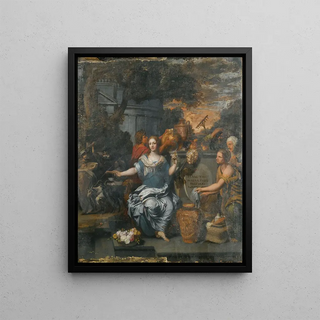Art print | A sacrifice for Easter - Gerard de Lairesse


View from behind

Frame (optional)
In the vast panorama of art history, certain works stand out for their ability to evoke deep emotions and transport the viewer into a universe that is both mythical and symbolic. "Un sacrifice pour les Pâles" by Gerard de Lairesse is one of these creations that, through its visual and narrative intensity, captures the attention of art enthusiasts. This piece, rich in details and meanings, perfectly illustrates the harmony between pictorial technique and allegorical content, making each glance an invitation to contemplation. The artist, through this work, manages to establish a dialogue between the sacred and the profane, between the human and the divine, immersing his audience in a reflection on the rituals and beliefs of his time.
Style and uniqueness of the work
Gerard de Lairesse's style is characterized by a classical approach, where light and shadow play a predominant role in the composition. In "Un sacrifice pour les Pâles," the chosen color palette, oscillating between warm tones and cooler shades, creates an atmosphere that is both solemn and vibrant. The characters, dressed in elegant drapery, are depicted with anatomical precision that demonstrates the artist's technical mastery. Every gesture, every expression is carefully studied to convey emotional depth, rendering the protagonists almost lifelike. Moreover, the dynamic poses and the arrangement of figures within the pictorial space testify to a skillfully orchestrated composition, where each element contributes to the whole, inviting the viewer to explore the multiple layers of meaning hidden behind this poignant scene.
The artist and his influence
Gerard de Lairesse, a Dutch painter of the 17th century, left his mark on his era through his innovative approach and commitment to the principles of classicism. Influenced by the great masters of the Renaissance, he developed a style that combines rigor and poetry. His career, although marked by success, was also marred by personal trials, notably the loss of his sight, which ended his artistic practice. Despite this, his legacy endures, inspiring

Matte finish

View from behind

Frame (optional)
In the vast panorama of art history, certain works stand out for their ability to evoke deep emotions and transport the viewer into a universe that is both mythical and symbolic. "Un sacrifice pour les Pâles" by Gerard de Lairesse is one of these creations that, through its visual and narrative intensity, captures the attention of art enthusiasts. This piece, rich in details and meanings, perfectly illustrates the harmony between pictorial technique and allegorical content, making each glance an invitation to contemplation. The artist, through this work, manages to establish a dialogue between the sacred and the profane, between the human and the divine, immersing his audience in a reflection on the rituals and beliefs of his time.
Style and uniqueness of the work
Gerard de Lairesse's style is characterized by a classical approach, where light and shadow play a predominant role in the composition. In "Un sacrifice pour les Pâles," the chosen color palette, oscillating between warm tones and cooler shades, creates an atmosphere that is both solemn and vibrant. The characters, dressed in elegant drapery, are depicted with anatomical precision that demonstrates the artist's technical mastery. Every gesture, every expression is carefully studied to convey emotional depth, rendering the protagonists almost lifelike. Moreover, the dynamic poses and the arrangement of figures within the pictorial space testify to a skillfully orchestrated composition, where each element contributes to the whole, inviting the viewer to explore the multiple layers of meaning hidden behind this poignant scene.
The artist and his influence
Gerard de Lairesse, a Dutch painter of the 17th century, left his mark on his era through his innovative approach and commitment to the principles of classicism. Influenced by the great masters of the Renaissance, he developed a style that combines rigor and poetry. His career, although marked by success, was also marred by personal trials, notably the loss of his sight, which ended his artistic practice. Despite this, his legacy endures, inspiring






